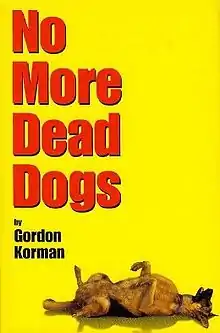No More Dead Dogs
No More Dead Dogs is a novel by Gordon Korman published in 2002.
 First edition | |
| Author | Gordon Korman |
|---|---|
| Language | English |
| Genre | Children's novel |
| Published | 2002 (Hyperion Books) |
| Media type | Print (Paperback) |
| Pages | 192 |
| Awards | 2002 Young Reader's Choice Award (Intermediate)[1] |
| ISBN | 0-7868-1601-5 |
| OCLC | 50608674 |
Plot summary
Ever since Wallace was young, he has insisted on telling the truth. Since scoring the winning touchdown for the Bedford Middle School football team in the championship, Wallace Wallace has been very popular, to the dismay of his ex-best friend, Steve Cavanaugh (two running gags in the book are Cavanaugh calling Wallace by a double insult, e.g. Dummy Dummy, and Wallace thinking of Cavanaugh by the last name only).
When Wallace is assigned to write a report on the book Old Shep, My Pal, he won't lie about his feelings. He dislikes the book and writes a negative review, which results in detention handed down by his Old Shep, My Pal-obsessed English teacher, Mr. Fogelman, and booted from the school football team until he writes a quality review. His detention is spent with the drama club. The drama club is led by Mr. Fogelman, and they are working on a production of a dramatic adaptation of Old Shep, My Pal written by Mr. Fogelman. Wallace is initially bored, much to the irritation of Mr. Fogelman and Rachel Turner, the president of the drama club. Trudi Davis, Rachel's best friend, is in love with Wallace, to Rachel's dismay. During Wallace's detention, he decides to make edits to the script. Mr. Fogelman is annoyed at Wallace because he thinks the drama club should stick to exactly how the book is. The drama club likes the changes that Wallace is making, and later Wallace joins the club.
Soon after Wallace joins the club, an unknown person vandalizes the playset and rehearsals. Rachel believes Wallace is the culprit. Everyone else, Trudi in particular, initially regards him as a hero and refuses to believe her, but when one of Wallace's scrimmage jerseys appears during the final sabotage attempt, they turn against him. Rachel changes her mind to believe that Wallace isn't the vandal.
Wallace is eventually banned from the play entirely. Despite his ban, the drama club decides to use Wallace's ideas for the play, including having Shep live at the end. This decision results in disaster when the saboteur blows up the stuffed prop Shep with a cherry bomb during the performance—just as the actors praise his miraculous recovery.
Meanwhile, Wallace figures out that the culprit is Rachel's younger brother Dylan, who wanted revenge because he felt the play had ruined the famous Wallace. Consequently, Wallace tells his first lie to spare Rachel's feelings. He tells her that it was him vandalizing the play. After her initial anger at Wallace, she realizes on her own that Dylan was behind the attacks. Wallace and Rachel recognize their mutual attraction and plan to go on a date together. As for Trudi, she ends up falling in love with Cavanaugh. Furthermore, Cavanaugh and Wallace do not makeup and are still enemies. Just not archenemies. The joke is on Cavanaugh because Wallace tackled Shep with a pillow to block the explosion, mimicking his previous winning touchdown.
Reception
In a review for Book Report, Jo Clarke said that "this was one of the funniest books I have ever read!" and that "Middle school kids will enjoy this book because it is so typical of their language, actions, and ideas."[2] However, the Journal of Adolescent & Adult Literacy review said that "the book is filled with jokes aimed at an adult audience rather than one comprised of middle schoolers. These are jokes that desperately wish to be funny but the book produces only one that would be considered genuinely amusing to its demographic" and that "No More Dead Dogs had serious potential to be a much better book than the writing produced."[3]
References
- "Young Readers Choice Award". Powells.com. Retrieved 14 December 2012.
- Clarke, Jo (March–April 2001). "No More Dead Dogs (Book Review)". Book Report. 19 (5): 60.
- "Books for adolescents". Journal of Adolescent & Adult Literacy. 46 (2): 178. October 2002. ISSN 1081-3004.